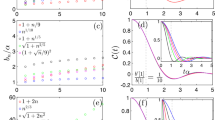Abstract
We estimate discrete Fourier transform, ambiguity, and Hamming-auto-correlation of \(m\)-ary sequences in terms of their (periodic) correlation measure of order 4. Roughly speaking, we show that every pseudorandom sequence, that is, any sequence with small correlation measure up to a sufficiently large order, cannot have a large discrete Fourier transform, ambiguity, or Hamming-autocorrelation. Conversely, there are sequences, for example the two-prime generator, with large correlation measure of order 4 but small discrete Fourier transform, ambiguity, autocorrelation, and Hamming-autocorrelation.
Similar content being viewed by others
References
Brandstätter N., Winterhof A.: Linear complexity profile of binary sequences with small correlation measure. Period. Math. Hung. 52(2), 1–8 (2006).
Cassaigne J., Mauduit C., Sárközy A.: On finite pseudorandom binary sequences. VII. The measures of pseudorandomness. Acta Arith. 103(2), 97–118 (2002).
Chen Z., Winterhof A.: Linear complexity profile of m-ary pseudorandom sequences with small correlation measure. Indag. Math. (N.S.) 20(4), 631–640 (2009).
Fuji-Hara R., Miao Y., Mishima M.: Optimal frequency hopping sequences: a combinatorial approach. IEEE Trans. Inf. Theory 50(10), 2408–2420 (2004).
Golomb S.W., Gong G.: Signal Design for Good Correlation: for Wireless Communication, Cryptography, and Radar. Cambridge University Press, Cambridge (2005).
Gong G.: Character sums and polyphase sequence families with low correlation, DFT and ambiguity. In: Charpin P., Pott A., Winterhof A. (eds.) Finite Fields and Their Applications: Character Sums and Polynomials. Radon Series on Computational and Applied Mathematics, pp. 1–41. de Gruyter, Berlin (2013).
Gyarmati K.: Measures of Pseudorandomness. In: Charpin P., Pott A., Winterhof A. (eds.) Finite Fields and their Applications: Character Sums and Polynomials. Radon Series on Computational and Applied Mathematics, pp. 42–64. de Gruyter, Berlin (2013).
Lempel A., Greenberger H.: Families of sequences with optimal Hamming correlation properties. IEEE Trans. Inf. Theory 20, 90–94 (1974).
Liu H., Gao J.: Pseudorandom binary sequences with composite moduli. Acta Math. Sin. (Chin. Ser.) 55(5), 869–880 (2012).
Liu H., Zhan T., Wang X.: On the correlation of pseudorandom binary sequences with composite moduli. Publ. Math. Debrecen 74(1–2), 195–214 (2009).
Mauduit C., Sárközy A.: On finite pseudorandom binary sequences. I. Measure of pseudorandomness, the Legendre symbol. Acta Arith. 82(4), 365–377 (1997).
Mauduit C., Sárközy A.: On finite pseudorandom sequences of \(k\) symbols. Indag. Math. (N.S.) 13(1), 89–101 (2002).
Rivat J., Sárközy A.: Modular constructions of pseudorandom binary sequences woth composite moduli. Period. Math. Hung. 51, 75–107 (2005).
Shparlinski I.: Cryptographic applications of analytic number theory. Complexity lower bounds and pseudorandomness. Progress in Computer Science and Applied Logic, vol. 22. Birkhäuser, Basel (2003).
Weil A.: Basic Number Theory. Reprint of the second (1973) edition. Classics in Mathematics. Springer, Berlin (1995).
Acknowledgments
The research of G. I. Pirsic has been supported by the Austrian Science Fund (FWF), P23285-N18.
Author information
Authors and Affiliations
Corresponding author
Additional information
This is one of several papers published in Designs, Codes and Cryptography comprising the “Special Issue on Coding and Cryptography”.
Rights and permissions
About this article
Cite this article
Pirsic, G.I., Winterhof, A. On discrete Fourier transform, ambiguity, and Hamming-autocorrelation of pseudorandom sequences. Des. Codes Cryptogr. 73, 319–328 (2014). https://doi.org/10.1007/s10623-013-9916-2
Received:
Revised:
Accepted:
Published:
Issue Date:
DOI: https://doi.org/10.1007/s10623-013-9916-2



